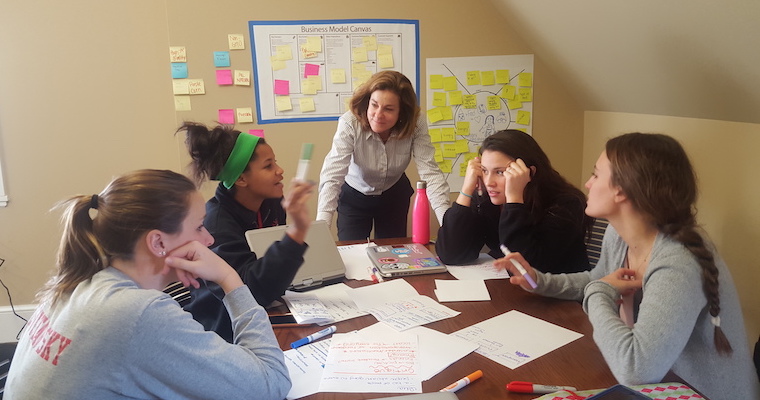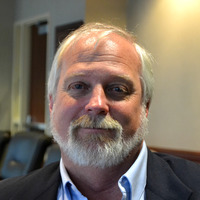A Lean Startup Approach to Engaging High School Students

EDITOR’S NOTE: Doris Korda spent more than a decade at Bell Labs and in several corporate ventures, one of which became a billion dollar software business. She made the switch to education 22 years ago and never looked back. Her first job was teaching math in a private school to ninth-graders no one wanted to teach and who did not want to learn. Without formal training as a teacher, Korda did what came naturally – developing teaching methods that engaged students in learning math through the lens of problems they cared about. As she further developed her methods to teach entrepreneurship, she used what she learned in the business world, incorporating a version of the Lean Startup template for building a business: test a hypothesis, refine it, pivot if necessary, then scale larger when the opportunity is right.
Through her firm, The Korda Institute for Teaching, Korda has since rolled out her methods to more than 190 schools, reaching more than 64,000 students worldwide. In this edited interview with EIX Editor Cathy Buday, Korda discusses how she discovered, refined and spread this revolutionary way of teaching.
'Why Do We Have to Learn This?'
Cathy Buday
What was it like for you switching from corporate executive to education?
Doris Korda
I was running a large, fast-scaling global business and had two young children. I decided to make a lifestyle change and moved from running the business to consulting for it. The high school principal at my daughter’s school found out and asked if I would teach a math class – one of their teachers had quit and they had a single class they wanted me to teach. So I went from running a large business unit to being a math teacher at a private high school a few days later. I had never taught before and had no training in teaching. My students were ninth-graders who were taking Algebra 1 all over again when their classmates had passed it in 7th or 8th grade. They were 14 years old, embarrassed and insecure, and I was given the textbook and told to just get them through it. One of my students asked me every day, “Why do we have to learn this?” I have to say that I wondered that myself, and I realized quickly that every day I had to come up with a reason for them to care about what they were about to learn. That meant finding real problems that math skills could solve for them.
One problem I used was the plight of the polar bear, whose natural habitat was changing. Before they could begin developing solutions, students had to understand the problem. Math is very useful to model and make sense of complicated situations with many variables. So students were highly motivated to learn the math they needed to frame and analyze the many factors that were leading to damaging changes to the polar bears’ habitat. The lessons stuck in a way that traditional math lessons don’t: just a few months ago I got an email from a student who was in my class 20 years ago; it started, “I’m writing to tell you how polar bears changed my life.”
Scaling Up
Cathy Buday
When did you realize you were on to something?
Doris Korda
About a year and a half after I started teaching, I was beginning to realize that the way I was teaching was radically different from what happens in most middle school and high school classrooms. I attended a master’s program in teaching at Columbia University and studied the cognitive science of learning. I learned the science behind what I’d discovered as a teacher: that humans learn new things best when they have to learn them in order to do something they want to accomplish. In other words, people learn best while doing something that matters to them. Students won’t learn for keeps by listening, watching or reading, which unfortunately is how most classes are still taught now. Schools are set up under a bad paradigm, where everything centers around standardized tests.
Cathy Buday
You taught largely in private school, where teachers are not as worried about standardized tests. How can this work in a public school?
Doris Korda
About 91% of students today are in public schools. I used the private school environment to test my concepts, then found ways they could be rolled out to the public schools’ more constrained system. Even with incredible results in private schools, this was challenging.
At first I had hoped to start my own public charter school for girls who had been in and out of foster care, but I ran across too many roadblocks because of state regulations on testing and transportation (busing was tied to jurisdictions and kids in foster care typically live in several counties during the course of high school). So I became associate head of school at an independent school that wanted dramatic change and was willing to serve as a laboratory to develop and test concepts. There I created an entrepreneurship class, where students could learn all kinds of knowledge and master critical skills while solving the problems of real businesses.
I developed methods in the private school environment that I then applied in public schools. And I developed a phased process for healthy school change over time. I’m a systems engineer by training, and every time I taught a new class or a new school I looked for ways to replicate what I did in a bigger way.
Educational Entrepreneurship
Cathy Buday
Why did you return to entrepreneurship and start your own education company?
Doris Korda
In the early years of my entrepreneurship class, I attended a Lean LaunchPad workshop for educators taught by Steve Blank, creator of the Lean Startup method. When Steve heard what I was doing, he encouraged me to do a workshop for educators. My first workshop ever, for 30 people, was in Steve’s living room. Everybody there told me I should keep doing this. I did, and my work with other schools exploded so that eventually I realized that I couldn’t also be a school administrator.
Soon afterward I started my nonprofit business,which we recently renamed the Korda Institute for Teaching, to help more schools adopt the methods that were working so well in our first classrooms. We work with schools to change how teachers teach and students learn. Entrepreneurship, as a process and mindset, is key to what we do, because through entrepreneurship students build skills that they will apply to all their classes. In my entrepreneurship class, for example, students learned biology and genetics while solving a problem for a genome tech startup. Before students could begin to develop their solutions, they had to go deep into problem identification and framing, so they also learned about the relationship between healthcare and poverty.
In a public school we worked with, an 8th-grade humanities teacher taught her students critical thinking, research and statistics as they solved a problem for a local social services organization: creating a plan to help Rohingya refugees succeed in their new home in the midwestern US. Regardless of the academic discipline, students learn while working on teams in an entrepreneurial way, collaboratively and under time pressure.
At first, the only students who signed up for my entrepreneurship class were the ones with relatively low GPAs. Parents and teachers advised students with higher GPAs to stick with AP classes instead. But as word spread about the class and as many of the students improved so much that they were using their portfolios from entrepreneurship class to get into competitive colleges, the class started to attract all kinds of students.
In the process I realized that I had been adopting Lean Startup to develop my teaching methods: agile development, testing my ideas, tweaking them, pivoting if necessary, then finally finding ways to scale up. And as students problem-solve, they develop hypotheses, learn to test, get out of the building and talk to real people, study and question the data, etc.
Whether it’s in my classes or in any of the hundreds of schools we’ve trained, teachers discover that the entrepreneurial process is powerful in engaging their students and, most importantly, getting them excited about their education.
Results
Cathy Buday
What have been are some of your best turnarounds?
Doris Korda
There is a public school in Columbus, Ohio, where students go when they’ve been expelled from their high school. It’s in a huge urban public school district, and students are expelled for really major things. Our work with them over the past three years has completely changed the school. We trained and coached teachers while working with the administration to change the school systems required for this sort of teaching and learning. And the results show up in the students: we have data to show the dramatic improvements in their academic performance, reduced infractions and increased graduation rates.
Another example: Ashtabula, Ohio, is the largest and least densely populated county in Ohio. It’s also one of the poorest, hit hard by the opioid epidemic. We are working with a public school district there, and now a new way of teaching is spreading across all kinds of classrooms and changing lives there. Teachers in the public schools we’re working with are changing how they teach and how their students learn. High school students in a rural public school district are learning about alternative energy and developing critical skills while they work to create a plan to convince the community to allow a new solar farm; middle school students learn while developing plans to reduce the numbers of unwanted cats for the Animal Protection League. There’s no such thing as a boring subject. It’s not about what you teach, it’s about how you teach it. People in the organizations that teachers use for their classroom challenges often say that they are blown away by students’ solutions and their depth of research; many of them saying they are beyond what their own staff has come up with.
Takeaways for Teachers
Cathy Buday
How can teachers and schools adopt your approach to helping students learn?
Doris Korda
The first step teachers should take is to approach their administration and get them behind the effort. This is about entirely changing the way we teach – it’s the long game. Schools need to have leadership that is committed to doing this. We then partner with the school and teachers to help them change the way they teach, one classroom at a time.
It won’t be easy. One of the problems is that the way most schools are still set up creates a deeply risk-averse culture. It’s the old industrial model that doesn’t encourage experimentation and collaboration; it’s set up for solitary work by both students and teachers. My system of teaching and learning is so radically different that you need to do what tech entrepreneurs do: start with a small pilot program that is smartly constructed and has immediately visible results. When teachers and administrators see the student learning (e.g., teachers reporting threefold gains in student communications over their previous classes), they decide to keep going, and go to the next phase of change-making.
Additional Search Terms: K-12 education, high school, middle school, entrepreneurship classes, learning, helping kids learn

